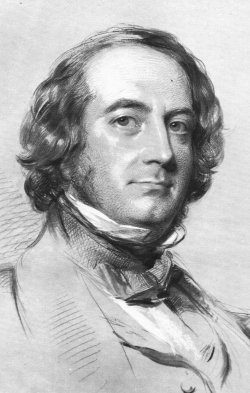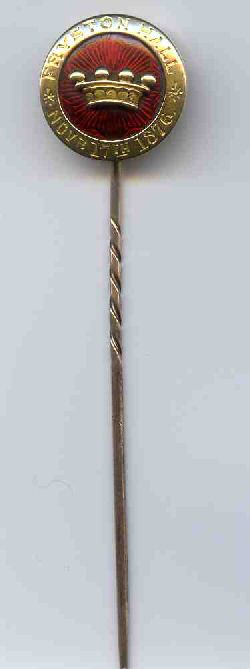| |
| 1825 - Fryston Hall |
| From this time onwards Fryston Hall was the meeting place of famous literary people as guests of Richard Monckton-Milnes, Lord Houghton, who was born there in 1809. He was M.P. for Pontefract from 1837 to 1863. Richard Monckton-Milnes was Florence Nightingale's romantic interest as far as history is concerned. Theirs was a seven year courtship but when Milnes, whom she called "the man I adore," begged her to marry him, she refused. Tennyson, Hallam, Maurice, French, Alford and Spedding all visited the Hall, and in 1841 we have Carlyle and Mr. Disraeli. In 1844 Richard Monckton-Milnes is portrayed as Mr. Vavasour in Disraeli's 'Tancred". In the last 20 years of the Nineteenth Century Prince Edward (Edward VII) was a frequent visitor and hunted in the Fryston Woods. |
| The Monckton-Miles library was famous in its day but unfortunately suffered from a major fire in 1876 after which some of the surviving books were dispersed and the remainder distributed among Lord Houghton's descendants. |
| The Hall was eventually demolished in 1934, the recovered stone being used to build the Holy Cross Church in Airedale. |
 |
| Richard Monckton-Milnes |
| A Chalk Sketch by George Richmond. |
 |
 |
| Cravat Pin |
| Inscribed: Fryston Hall - November 17th. 1876 |
| My thanks to Mr. & Mrs Dale for the following: |
| Lord Houghton and his son were staying at the Shelburne Hotel in Dublin on the night of the 16th. November 1876. It was here they received a telegram at 6:00am on the 17th. telling them the news of the tragic fire at Fryston Hall which had actually started on the 16th. of November 1876 at 10:30pm. The telegram simply stated that the Hall was on fire. Houghton also received the following news, "All valuables saved, except what was in the tower!!! All the front of the building was gone, from roof to entrance hall." |
| On the 20th. November, Houghton wrote to Henry Bright stating that his daughters had lost all their valuables, even documents, personal letters and childhood memories were now gone! |
| Although we can find no actual date for this piece of information it is on
official record that shortly after the fire, "Houghton made name of all those in service who had taken part in 'the brave efforts to save the Hall', and having secured lists made from all the individuals who volunteered. Houghton then presented a handsome token to each one, for their gallant efforts." |
| Of what he offered to each, no one knows!!!.... but this item could most certainly be one such result. |
 |
| More From: Mr & Mrs Dale. |
| First of all, it's a very attractive object. I don't know what it's made from, so I will assume that it is Gold and Silver (or Silver gilt), by its appearance. Part turned shaft, with the central emblem of that of a Baronial Crown. The red enamel background appears to emanate from the crown. This could be a representation of a bleeding heart, in abstract style! or to signify the blood, of a noble person (Baron Houghton!). On the outer band I can read "FRYSTON HALL NOV 17th 1876." |
| ("Here’s the hard part.") |
| The only reference I can find for that actual date is a letter written by Milnes to his daughter Jayne. (Both expressing their deep sadness regarding the fire). I agree, it does sound meaningless, to have made a cravat pin to signify the fire at Fryston Hall, yet I would not rule out this factor! |
| Throughout history when disasters, incidents and events have taken place people have struck, to name but a few, medals, postcards and even jewellery mark the occasion. |
| "This item may also be a personal loss at the time of the fire." Many of the Houghton family personal possessions were un-accounted for after the event. The biggest concern, being the family library! Not everyone present at the scene of the fire was a staunch supporter of the Houghton wealth. It was said by record, there was a multitude of pleasure seekers! No doubt, this item could have easily been picked up by one such person. Eager to pocket a small piece of Houghton’s wealth as a memento! And then to deface the outer band which would remove the previous owner's identity, leaving only the "Baronial Crown" which many families would have had incorporated into their family ancestral crest. A baronial crown, either on a badge, livery button, or item of personal adornment was fairly common in his friends circle. |
| I hope this may shed a little more light, hoping it adds to its provenance tracing its origins. But please note much of this lies in my own opinions. While others are taken from official entries, in connection to Lord Houghton's life. |
| Personally, I really hope the inscriptions to be contemporary too the time of engraving. But it seems a far reach to imagine Houghton, or a member of his family / or even a close friend having sent this as a gift. (Who would have worn the cravat pin, without having a deep sense of sadness from the event?) |
| We hope you find some of this information of interest, in response to its provenance and to that of its origins. |
 |
| Return To The History Menu |

